K. Lang-Slattery's Blog, page 5
November 8, 2020
An Indie-author’s Quest for Book Reviews
As an indie-author/publisher, my work does not stop when a book is released. Unlike 4 years ago when I launched Immigrant Soldier, 2020, with its Covid-19 shut-downs, has made live visits to bookstores, libraries, and book groups impossible. These days, my publicity efforts must center on social media and gathering book reviews.
Getting reviews is (and always has been) an integral part of publicity. However large media outlets and prestigious journals still practice a kind of “book snobbery.” They seldom review books that are independently published. What’s an Indie-author to do?
The process of getting reviews is far different than it was only a few years ago. The big journals, most of which now also have an on-line presence, (Library Journal, Publishers Weekly, Kirkus, Foreword Reviews and the book sections of major newspapers like The Washington Post, Los Angeles Times, and The New York Times) still attract librarians, publishers, bookstore buyers, and discerning readers. But these titans of literary judgement are very selective. They have limited space and prefer to review books released by the big, traditional publishers. They also often require a long lead time, as much as 6 months before a book is released, and that can be difficult for a small publisher. Still, an author can try.
A few of the big guys, notably Kirkus, Publishers Weekly, and Foreword Reviews, also offer reviews to authors willing to pay a fee. These fees can be high! A paid review with Publishers Weekly will set an author back $399, Clarion/Foreword charges $499, and a Kirkus review goes for $425 to start. In general, a paid review is not considered as creditable as one for which the author didn’t shell out money, though their reputation is gradually improving. So why would an author pay these high fees?
• A guaranteed review (though not guaranteed to be favorable).
• Control over publication (in case you don’t like what the reviewer wrote.)
• Full rights to use all or part of the review in your own publicity as long as you properly credit the reviewer.
• A well-known journal name may impress readers.
Link to my Kirkus review: kirkusreviews
The U.S. Review of Books offers professional reviews for a reasonable cost starting at $99 (extra publicity perks can be added for more money). I opted for the second tier up (called Plus) which included a link and a book cover image. I received a beautifully written RECOMMENDED review in a timely fashion. theusreview.com
Luckily, the internet has opened up the review climate making free-lance reviewers easier to find. Indie-authors can search a variety of sources including author sites, book blogs, and special interest blogs. GoodReads, a social platform for readers, blogs, review sites, and the reader reviews on Amazon have become go-to sources for many avid readers. In fact, more and more book lovers look to the recommendations of other readers like themselves that they find on https://www.goodreads.com.
Finding freelance reviewers is a grueling task. In the last 6 months, I have spent many hours at my computer, researching potential reviewers, local newspapers, and book review web-sites. I read dozens of travel memoirs and contacted their authors. I checked out travel, RV, and van-life web-sites and Instagram accounts. I contacted the editorial staff of local newspapers. I wrote countless email requests introducing my book and asking for the favor of a review or even a short, one paragraph blurb.
Some contacts sent polite declines, a few remained totally silent, but occasionally a response came that lifted my spirits. After a yes answer, I sent the prospective reviewer an advance reader copy of my book either in paperback or as a pdf. Of the half-dozen books I sent out, only one writer did not returned the promised review. Most returned blurbs rather than full reviews, but all were positive and contained something quotable. Yea! And a few were really lovely!
A travel blogger from Australia, a total stranger, returned a review that captured the soul of my memoir:
“In the 1970s, for the first time, it became possible for responsible, middle-class 20-somethings to work for a few years and gather enough cash to spend the next few years wandering the world. In 1971, together with her newly acquired husband Tom, Katie Lang-Slattery hits the road in a Volkswagen microbus with no destination in mind other than somewhere farther down the road. . . Wherever the Road Leads is a fond and evocative recollection of a world that has changed beyond all recognition. It’s not all roses and gilded sunsets but a heartfelt and sinewy account, full of fragrant moments as they roam free, laying down a bed of memories to treasure and share half a century on.” – Michael Gebicki, travel writer, photographer and columnist at www.traveller.com.au
In general, free-lance reviewers will post their review on Amazon and GoodReads and they all gave me permission to use their words in my publicity, on the back of my book, and on my web-site. GoodReads and Amazon feature reader reviews, so fans can become reviewers of any book they read.
The following are a few quotes from reviews for Wherever the Road Leads:
“Slattery is a good writer. Her smooth prose is injected with warmth, humor, and insightful observations of the many cultures she encountered. I enjoyed the sights, tastes, and details she relates experiencing on travels from Mexico to India, and many points between. . . . .Reading this book was experiencing a window of history, during a pivotal decade, pertaining to travel without the convenience of modern technology.” – Janilyn Kocher for Story Circle Book Reviews
“An unvarnished view of a massive trek from California to Central America to Europe, the Middle East and Asia, this book doesn’t skimp on detail but brings to life this astonishing adventure. Down to earth accounts of what the day to day life was, doing the laundry, bathing, buying food and cooking it in the very limited facilities of a Volkswagen van ground this account in the realities of travel-on-a-tiny budget so characteristic of the young of many countries in the early 1970s. It was a time of bravery, of a spirit of romance and adventure hardly seen since.” – Indie B.R.A.G. (Medallion Honoree)
“I loved reading this astonishing story – made more pleasurable for me by the frequent insertion of drawings, photos, and maps.” – Sue Boardman, reader
“If you’ve ever dreamed of a two-year camping honeymoon exploring the world, this book is a must-read. With Tom and Katie, you’ll camp and cook on the banks of the Tiber, sleep in a van under the Eiffel Tower, and discover markets from Marrakesh to Kathmandu.” – Georgeanne Brennan, author of A Pig in Provence-Good Food and Simple Pleasures in the South of France.
“Delightful illustrations and vintage photos enhance the fascinating stories.” – Jill G. Hall, author of The Green Lace Corset.
“Youth does have its advantages and the skill and grit these two had was something beyond extraordinary. A delightful read, and one which you can thoroughly enjoy with gratitude—that you are simply reading and not having to tear that microbus apart one more time.” – Carole Bumpus, author of A Cup of Redemption and Searching for Family and Traditions at the French Table.
“To travel the world in a Volkswagen van is a dream of many travelers. This account of a young couple who did just that will spark wanderlust and make you ponder the possibilities of hitting the open road. A remarkable adventure and a delightful read.” – Janice MacLeod, New York Times best selling author of Paris Letters.
“This rosy glow follows the couple throughout their escapades and encounters. Recreated dialogue and descriptions lend a ‘you are there’ feel to the story.” – D. Donovan, Senior Reviewer, Midwest Book Review
* * * *
Have you ever taken the time to write a review on Amazon or GoodReads? What makes you willing to take the extra time this takes? If you do, we authors thank you. Every honest review is welcomed!
The post An Indie-author’s Quest for Book Reviews appeared first on Klang Slattery.
October 23, 2020
Covid-19 Journals
Recently I spent a few hours looking through my dozens of travel journals. As I flipped through the pages, it occurred to me that now, during the Covid-19 pandemic, would be a good time to keep a diary. Unlike many who love to write, I’ve never been a consistent journalist. In fact, the only times I try to keep a daily account of my life is when I’m traveling. Over the years, I’ve developed a personal style that works for keeping track of all the little frustrations and joys of being on the road.
With all that is going on in our world these days, everything from the upcoming election to Black Lives Matter, from the pandemic to the failing economy, from challenging personal demons to fighting for our endangered earth—this is a time that needs to be recorded by we who are living it. As a dedicated reader of historical fiction and biography, I know that the best books of these genre are often inspired by, or at least improved by, the discovery and study of contemporaneous journals or letters. My own historical WWII novel, Immigrant Soldier, was aided by the letters my uncle Herman wrote to his mother, and my memoir, Wherever the Road Leads, would not have been possible without the saved, journal-style missives I wrote home to family.

from my sketchbook journal, 1960
My collection of travel journals includes a basic sketchbook done at the age of 17 during my first trip to Europe, almost two dozen small notebooks written longhand, and one more recent version which was tapped out on my laptop.
Travel is an extraordinary activity that takes us away from our everyday lives and thus is interesting to record. Now, most of us are unable to travel and many are unwilling to leave their homes without a good reason. This unusual and disturbing year is turning into a journey that needs to be documented—and not only by political pundits and news journalists.
Here are 6 suggestions for tackling a journal in 2020:
Set your own schedule. A long journal isn’t necessary. Travel journals only cover a specific time when you are on vacation. You may want to make entries every day for only a month or once a week until January 2021. Feel free to adjust your goal after you see what schedule works best for you.
Set a time-frame relevant to your own life. All my journals begin with a token that sets the narrative into a specific time. As a mom, I like to glue a picture of my children on the first page. The changing faces of my kids immediately identify the time in my life when I took any particular trip. For you, it might be a photo of your partner, your pet, your home, or a photocopy of your driver’s license or passport picture. Even with a visual reminder, be sure to write down the full date you begin.
Think outside the box. A journal doesn’t need to be all interior monologues or a chronological recitation of what you do each day. Try a creative format. You could write in the form of letters to different people, or start each entry with the day’s newspaper headlines. If you’re not into writing, why not create a “diary” scrapbook adding notes and explanations only if needed. When I was in high school, I kept old-fashioned scrapbooks— the kind where you paste in mementos without any embellishments from the crafting supply store. For four years, I glued every movie ticket, dance invitation, Chinese-cookie fortune, Valentine’s card from a boyfriend, and dried, crushed corsage onto those manilla pages. How I wish I had kept those books! They would have been a window into the 1950s.
Include the good and the bad—Your frustrations and the hurdles you surmounted AND happy or funny experiences. Let your feelings be your guide. But don’t neglect facts, conversations, or interesting lists . . . like all your Zoom meetings in one week, the books you have read in one month, new recipes you have tried, or how many hours you spent volunteering or in the line at the food bank. No material is off limits unless you designate it as such. This is your book and it’s yours to share or not.
Pictures add meaning. If you like to draw, sketch in the margins or fill an entire page with your art. At the age of 10, my sone traveled alone to visit his cousin in Denmark, a new journal packed in his suitcase. Though a somewhat lazy writer, he added lots of funny drawings to his pages. They continue to delight me whenever I see them.
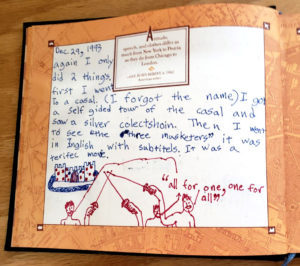 If you don’t draw, you can cut and paste all kinds of media into your journal, anything from timely magazine ads to a Sunday funnies comic strip that deals with current happenings. Or download your favorite meme from social media and import it into your document.
If you don’t draw, you can cut and paste all kinds of media into your journal, anything from timely magazine ads to a Sunday funnies comic strip that deals with current happenings. Or download your favorite meme from social media and import it into your document.Make your journal timely. Twenty, thirty, fifty years from now, family or researchers will want to know what it was like to live in 2020. Don’t neglect the special aspects of your daily life that are different now from before. This might be information about family or friends who contacted Covid-19 or experienced a natural, climate related disaster. Or you can describe the changes in the culture around you like the proliferation of different face-coverings displayed near every checkout stand or the greeters at the entrance to your doctor’s office checking the temperature of everyone who enters. These details will be of interest to those who come later. For you, writing about your experiences day to day, may help you process, evaluate, and come to terms with this year. Are some changes for the better? What did you learn about yourself during 2020? How do you think all the changes we have seen in 2020 will play out in the future? What will be our new normal?
If you are writing a 2020 journal, I’d love to hear from you with excerpts from your entries!
The post Covid-19 Journals appeared first on Klang Slattery.
October 9, 2020
Maps for a Travel Memoir
From the very beginning, I knew Wherever the Road Leads needed maps. Once the early manuscript draft was sent to Beta Readers for feedback, I filled the waiting time working on the seven maps I envisioned. I wanted them to show the journey’s route, major stops along the way, and display a few small drawings.
Years ago, I took 2 semesters at a local community college learning Adobe PageMaker, a desktop publishing program. Over the years, I have used it many times. I created news-letters, posters, invitations, and even the 50th reunion memory book for my High School class of ’61. I felt confident working in PageMaker.
Using the internet, I located basic maps of the areas we traveled. First, I printed them and traced the outline of the section I wanted to use. I included country borders, rivers, and a few city locations. Freehand, I added in a line with direction arrows to show where Tom and I traveled. I scanned the tracing into my computer and it became the foundation of my map. After that, I dropped in art work, arrows, and text. I worked on the maps one at a time. By the time the Beta Readers comments started to be returned, I had more or less completed 4 maps. They still needed fine tuning and 3 maps remained to unstarted. But it was time to get back to writing and editing. I set the map project aside where it remained on hold for half a year.

Finally, I was ready to finish the maps. But when I tried to open my files, the PageMaker program simply flickered, then disappeared. Over and over I tried, but the same thing happened each time. I was frustrated and worried. The old program was no longer supported by Adobe, but I innocently thought the installed program was mine to keep using it as long as I didn’t need help with it. Happy working with the old program, I had not bothered to learn InDesign (Adobe’s replacement). What a mistake!
A call to technical help at Adobe revealed that they had eradicated PageMaker from my computer. It was simply no longer available to anyone. Needless to say, I was angry and frustrated. I had no way to open my map files. I looked into taking a class on InDesign at the local community college, but the classes offered covered all three of the current Adobe programs. None of them dealt with only InDesign. Besides, the cost of class and the new program, the learning curve would pose a scheduling problem. I had writing and more editing to do and the search for an agent or a publisher to begin.
Just as I was beginning to feel at a dead-end, I remembered Cole Waidley, a young graphic designer who helps with my book covers, bookmarks, and other graphic needs. He knows InDesign and uses it regularly.

Problem solved—and for the better. Cole agreed to take over the maps. InDesign allowed him to open my old files and convert them into the new program. From there he was able to fine-tune my maps and create the new ones using my selection of scanned files. He was far better than I at inserting arrows, varying the size and quality of lines, text and images. Using my original concept, Cole effortlessly executed the seven maps I needed and prepared the files so they were ready to upload to the book designer. He also helped me improve the illustration I had drawn to show the inside layout of our van.
In a way, the demise of PageMaker was a happy accident. Cole is constantly ready to help with changes and new uploads as the final book is being proofed. Most recently, he fixed a spelling error found on the van schematic during a final proof read. Thank you, Cole!
https://colewaidley.crevado.com/
The post Maps for a Travel Memoir appeared first on Klang Slattery.
September 18, 2020
Readers Can Help Get the Word Out
Trying to launch a new book during the Covid-19 Pandemic calls for special tactics. Normally, I would be setting up in-person author visits at bookstores and giving presentations and talks at libraries and to book groups. Now, with personal appearances impossible, I’m trying to figure out new, digital ways to let readers know about my upcoming memoir, Wherever the Road Leads. I am in the midst of planning a fun, virtual Webinar-style launch party for the first week of December and I’m turning to you, my friends and readers, to ask a favor.
Yes, you can help! I’ve put together a list of ways you can help get the word out about my new book. I hope you will find something that fits your time and interests. Just a few minutes on line is all some of these suggestions will take—anything you can do will be appreciated. Of course, if you have other authors you love, these suggestions can be used to help them as well.
If you are an e-book reader, you may have already read Wherever the Road Leads and peer reviews are becoming ever more important! Please leave a review of my memoir on your favorite platform: Amazon, Goodreads, Smashwords, Barnes and Noble, Onlinebookclub.org. If you have read my novel, Immigrant Soldier, The Story of a Ritchie Boy, it is never too late to help out with a review for that book as well.
Are you waiting to read my memoir in paperback? I have several advance reader copies available for FREE if you commit to posting a review on Amazon and Goodreads or any other book site you use. I can hand deliver if you live in south Orange County, California. The U.S. postal service is so slow right now that regular mail can take up to 6 weeks to arrive anywhere! I know this from personal experience shipping books. Thus I must give preference to local readers, but if you’re a fast and motivated reader, I’m open to mailing you a free paperback.
A few additional ideas:
If you read my blogs, please send comments via the comment form at the bottom. It’s fun for me to see what you think and your comments will encourage others. Interaction with “fans” is a great way for me to know what you enjoy reading.
If one of my blogs is a subject that might be of interest to a friend, please share with them. You can also encourage them to fill out the comment form or subscribe to my blog.
Would your book group enjoy reading Wherever the Road Leads? I will be happy to Zoom with your group when you discuss the book. If you are a local south Orange County, California group and want to purchase autographed copies for your members directly from me, I can deliver the books.
Instagram – Maybe a picture of you holding up the book or your e-reader and saying how much you liked it. Please include the title in your comment. I can supply you with a book cover image if you prefer.
Post a comment about the book as a guest on my Facebook author page (Kathryn Lang-Slattery) and follow. Anything from “I can’t wait to read this” to a short blurb review and a picture of you holding the book. You could also post something on your own timeline.
Share to your Facebook timeline my posts from Kathryn Lang-Slattery about Wherever the Road Leads.
If you tweet, please say something about my book. Hashtags that link to things like van-life, travel, road trips, reading, and memoirs would work, I think. Other than that, you’re on your own because I am not a tweeter.
Best of all, if you are not already a member, join an on-line readers’ site. I suggest are Goodreads and/or the Online book Club. Sign on and follow these step-by step suggestions:
Create an account or go to your existing account.
Go to your bookshelf and add Wherever the Road Leads, A Memoir of Love, Travel, and a Van to your “want to read” list.
When/if you read my memoir, please leave a review.
At that point you can also scroll down to “recommend to a friend” and send your recommendation to anyone on your friend list who you think will like the book.
When you are on the book’s page, look to the right side and you will see “about K. Lang-Slattery.” Click on that to go to my author page where you can (please) follow me.
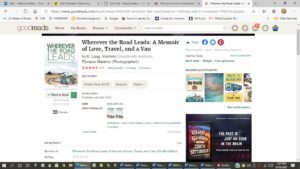
Create an account or go to your existing account.
Go to bookshelves (blue rectangles on top right of page). Dropdown menu will show “your shelves” – click on that and you will be sent to a page where you can add books you are reading or want to read.
At the top of this page in small print you will see Find A Book| Shelves FAQ | BOTM | Add A Book | Your Shelves. Click on Add A Book. You should be dropped to the bottom of the page to a large blue square where you can manually add books to your shelves.
Add Wherever the Road Leads, A Memoir of Love, Travel, and a Van
Author should be K. Lang-Slattery
Be sure to add information about shelf (want to read or currently reading). If you have read the book, you can add a rating and a review.
AND Please leave a comment below in the comments section after this blog. You can also receive automatic notice of all my blogs by filling in your email address and clicking on the blue SUBSCRIBE button.
Many thanks! Looking forward to hearing from you!
The post Readers Can Help Get the Word Out appeared first on Klang Slattery.
September 11, 2020
Climbing the Mango Trees
I am at it again – reading memoirs. Recently I was lucky enough to find the delightful memoir, Climbing the Mango Trees, A Memoir of a Childhood in India, by Madhur Jaffrey.
I’ve always loved memoirs by chefs and cooks and food writers. The recipes many include are a bonus, but I also enjoy them because I am constantly thinking about cooking. Its a relief to realize I’m not the only one. A few of my food-writing favorites are Tender to the Bone by Ruth Reichl, A Pig in Provence by Georgeanne Brennan, Lunch in Paris by Elizabeth Bard, Shark’s Fin and Sichuan Pepper by Fuchia Dunlop, and Mastering the Art of French Eating by Ann Mah.
 Though Climbing the Mango Trees has some recipes, it mainly tells a story of growing up in an upper-class Hindu family in Delhi from the 1930s through the early 1950s. As a cookbook collector, I have known Madhur Jaffrey for her many works on Indian cooking, a few of which I own. I also was familiar with her career as an actor who often appeared in films produced by Merchant Ivory, a movie company founded in India in 1961 to produce English language films there. Madhur’s memoir recounts growing up in a large extended family during the final years of British India, independence, and the tumultuous times of the 1947 Partition.
Though Climbing the Mango Trees has some recipes, it mainly tells a story of growing up in an upper-class Hindu family in Delhi from the 1930s through the early 1950s. As a cookbook collector, I have known Madhur Jaffrey for her many works on Indian cooking, a few of which I own. I also was familiar with her career as an actor who often appeared in films produced by Merchant Ivory, a movie company founded in India in 1961 to produce English language films there. Madhur’s memoir recounts growing up in a large extended family during the final years of British India, independence, and the tumultuous times of the 1947 Partition.
Having visited India twice (once during the time of my memoir Wherever the Road Leads and later in the 1990’s with my sister), its always fun to read about the places I’ve seen. Though I was not invited to visit the home of wealthy Indians, I can easily picture Jaffrey’s family enclave on the fringes of the huge city of Delhi. She describes trips to the “Old City” where her mother allows the children to eat hot food from street vendors and visits with her father to the Red Fort. Her memories bring back my own—the spicey and earthy flavors of potato samosas still hot from the kadai of boiling oil, the dusty streets, the beggars, the tiny shops with the owner sitting cross-legged on a platform outside selling terra-cotta bowls of creamy yogurt or cups of hot milky chai.
After Partition and the influx of refugees from western Punjab, Jaffrey describes her introduction to tandoor style cooking. A new tandoori restaurant, Moti Mahal, became all the rage with the young adults in Jaffrey’s crowd of college students. They would pick up tandoori roast chicken and naan to take home for late night snacks. The Moti Mahal restaurant was still popular in 1973. Tom and I ate lunch there and took extras back to the van for dinner.
Madhur admits that as a young woman she did not cook, though she always loved to eat. Her memoir ends soon after her graduation from college and gives no clue how she learned to cook and became a world-class cookbook author. This is a second memoir waiting to be written.
Still, she shares a selection of family recipes grouped at the end of the book. They are not fancy Mogul dishes, but real home-style recipes. Jaffrey describes her family as Hindu with north-Indian Muslim and British influences. The men and all the children spoke both Hindi and English, but the women of Madhur’s mother’s generation and older spoke only Hindi. The older women also tended to hold to their vegetarian traditions while the men, who had more contact with the power-players of government and business, loved meat. Some were even avid hunters. The recipes presented run from Shami Kebab (lamb patties) and duck curry with coriander and cardamom to vegetarian staples such as chickpea-flour soup with dumplings and mung bean fritters in yogurt.
If you are interested in reading an excellent story of upper-middle-class life in India in the mid-twentieth century, a story that highlights love of family and food, I heartily recommend Climbing the Mango Trees. For myself, I can’t wait to try Madhur Jaffrey’s recipe for Shami Kebab.
Vocabulary:
Chai – literally translates as “tea” in Hindi. In India plenty of hot milk and sugar are added to tea and often spices are blended in as well. Chai shops can be found on almost every street.
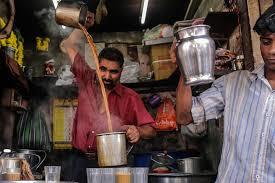

Kadai – a round bottomed pan used for deep frying.
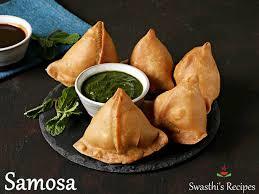
Samosas -deep fried pastries stuffed with various fillings such as spicey potatoes or minced lamb.
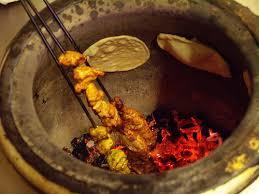
Tandoori style cooking – food cooked over an intense fire in a tandoor, a deep, cylindrical, clay oven. Meat is usually cooked on long, metal skewers lowered into the oven. Flat-breads like naan and roti are slapped against the hot clay sides of the oven where they stick while cooking.
The post Climbing the Mango Trees appeared first on Klang Slattery.
August 29, 2020
Memory of a Beijing Market
March 2003.
Tom burst into the room as I finished my second cup of tea. “I’ve found the market,” he announced. “It’s just around the corner.”
We had arrived in Beijing the afternoon before. After checking into the hotel, eating a Chinese meal in a dining room filled with western tourists, and wandering Tiananmen Square in the falling dusk, we fell into bed, heavy with travel fatigue. But our body clocks were not yet on Beijing time and we were both wide awake while the city still struggled to turn night into morning. My husband, normally an early riser, decided to explore the neighborhood as dawn slowly crept through the alleyways. I opted for a quiet moment with hot tea and a guide book.
When Tom burst into the room an hour later, I grabbed my shoes, my camera, and my shopping bag. Local markets are my favorite way to get to know a new country. Morning mist hovered in the air as we crossed a wide boulevard clogged with bicycles.
Thirty years before we had started our travels together with a two-year trip from California to Panama, to Spain, to Norway and finally to India and back–all in a Volkswagen camper equipped with a stove and a nested set of cookware. Early in that trip we learned to judge a place by its markets. These bustling sites of food and commerce were always a window onto the prosperity, culture, and friendliness of the land. Though we had been to many other places on the Asian continent, this was our first time inside China. We knew the market would offer a glimpse of the everyday people of China, a country famous for its cuisine and love of food.
We headed down a narrow lane that dead-ended at another alley to form a T shaped intersection. This was where the world of food began. On the sidewalk tiered aluminum steamers balanced over steel drums that contained cooking fires fueled by charcoal. The towering steamers emitted vapors redolent of garlic and ginger. Further on, the wide-open door of the market proper beckoned. We worked our way past a clutter of parked bicycles, push-carts, and cages of live chickens and into a market dimly lit by incandescent bulbs hanging from the high ceiling. The aisles teemed with shoppers and sellers. Men pushed wagons of produce down narrow aisles and women lugged heavy bags and boxes into their stalls. Vendors bagged sales, made change, and gestured behind counters heaped with food stuffs of every rainbow hue. Amidst all the activity, the market was clean and the floor was wet from a recent hosing down.
One side of the building was lined with banks of fruit rising almost to the ceiling. It was early spring, yet we saw watermelon, bananas, mangos, papayas, bright red apples, citrus of all kinds, including tangerines wrapped in vivid orange tissue, and huge round Asian pears nested in Styrofoam netting. Across the aisle, mounds of vegetables in all shades of green, white and yellow stood in towering displays–firm cabbages, leafy greens, snowy white giant Daikon radishes, thin Chinese long-beans, drooping Chinese chives, and the knobby green shapes of bitter melon. Nearby stood tubs of bean sprouts and trays of tofu arranged to display great hunks of bean curd from creamy white to golden brown, fresh, smoked, baked, and pressed. Across the bustling center aisle, dried and powdered things of all kinds filled small specialty shops–herbs, spices, dried shrimps and bottles of oyster sauce were stacked to the roof.
If only I had a wok and a single burner! A frustrated cook, I used my camera to capture the essence of the market. Vendors smiled with pride as I focused for a tight shot of bok-choy and snow peas. They tried to talk to us and laughed along with our efforts to communicate our pleasure. Everyone was courteous and friendly, from the sweating men pushing loaded carts through the clogged aisles to the vendors and shoppers. Though we were the only Caucasians in the entire market, there was no pushing, yelling or staring at the foreigners.
At the end of the produce section, the market widened and we entered a second shed, a more spacious area lined with glass fronted shops. In one, live fish swam in tanks and glistening fillets of salmon and white fish lay on a clean marble counter. Nearby sides of lamb and beef hung from hooks and two men in the white caps of the Moslem minority turned them into shank, rib and loin cuts. Across the shed, plucked birds were lined up, pressed wing to wing, waiting to be chopped for stir fry. One narrow breasted and black skinned bird lay surrounded by other lighter chickens and we wondered, “What is he?” (I have since learned that these skinny, dark skinned fowl are prized for their flavor). At another stand two men and a woman were busy making fresh noodles and a kind of round flat bread.

We stood, our stomachs rumbling, and watched the bread being rolled out and cooked on a griddle. Both the bread and noodles were selling as fast as they were made. The yummy looking products were stuffed into bulging plastic bags and handed to shoppers who stood patiently in line.
The aromas and sights made me long to fill my shopping bag, but a prepaid breakfast waited for us at the hotel. Tom and I hesitated only a moment. We could not resist the sight of so much food. We bought a few crisp, seed studded rolls and two Asian pears and stuffed them in my bag. As we headed back toward the hotel, the aroma from the steamers on the lane wafted through the air. We looked at each other and then longingly at the row of dumpling sellers.
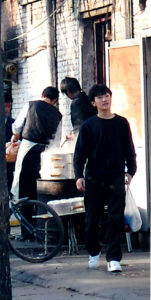
Suddenly neither of us had any interest in the breakfast in the hotel dining room. Tom grabbed my hand and we shouldered into the queue near the steamers. We pointed to our choices, nodded and smiled. Soon we stood at the edge of the road and savored each bite of our fluffy white steamed buns. Both were hot and succulent, the dough wrapping thin and light. The fillings–one chopped pork and onions, the other minced leeks and garlic–delighted our tastebuds.
I peeked into the brown paper bag of pastry. “Shall we?” I asked and Tom nodded. The flaky rolls were still warm, sweet and rich with a crust of sesame seeds.
The neighborhood Beijing market had fulfilled its promise and foretold many delectable experiences to come. After our first glimpse of the country at the morning market, we fell in love with China–the people were friendly, the towns and cities seemed on their way toward prosperity, and, best of all, the food was ample and delicious.
Do you share my love of food and markets when you travel?
The post Memory of a Beijing Market appeared first on Klang Slattery.
August 15, 2020
Collecting Fabric as a Travel Souvenir
A Facebook friend, a lady who is a master quiltmaker, recently posted a T-shirt with the following slogan emblazoned across the front: “I sew, but my favorite hobby is collecting fabric.”
Though I have never met his lady in person, we seem to have a lot in common. More than 50 years ago, I read somewhere (probably in one of the grocery store homemaker magazines I read), that fabric was always a good buy. The main take-away message emphasised that the cost of fabric was on the rise, would never go down, and stocking up on fabric would always be a cost saving ploy for anyone who liked to sew.
I took this message to heart and my husband, who loved to save money, supported my endeavors. An “almost hippie” of the 60s and a world-traveler, I have always been attracted to ethnic fabrics or any cloth typical of an exotic culture. As a result, fabric and fabric items, have been regulars on my travel souvenir list. I have filled my suitcases with tablecloths, napkins, and even items of clothing, but mainly yardage. Later, when I sewed for my growing daughter and occasionally put together a quilt as a gift for a friend’s baby, I often purchased extra fabric for future use. These days, my fabric stash consists mainly of a collection for never started projects, matched only by the baskets of sewing patterns I keep nearby.
Luckily, I inherited my mother’s cedar chest. She prized it because her older brother made it for her as a “hope chest,” that traditional repository of linens and other items a young girl collected to take to her new home after marriage. For years, the chest stood at the foot of my parent’s bed and my mother used it to store all her sewing supplies. Filled with fabric, bags of notions like elastic and snaps, a carved wooden box that held the extra sewing machine parts, a round metal box filled with spools of thread and another filled with buttons, is seemed to me a kind of treasure chest. From it came the party dresses my mother made for my sister and me. If I wanted to sew a doll dress, or (later) a ditty bag to take to camp, I was allowed to find the supplies I needed in the cedar chest.
Some years ago, the chest moved from my mother’s bedroom to mine. Now it is filled to the brim with fabric, a collection that overflows into an assortment of plastic tubs stacked on the top shelves of my closet.
My mother’s cedar chest is still a treasure box. It is where I keep the most valuable fabrics—cloth that brings back memories of the places where it was purchased. There are embroidered lengths from Central America, a few remaining scraps of tartan wool from Scotland, batik sarongs from Malaysia, silk saris from India, and a score of carefully folded bundles of various silk brocades from China. I will probably never sew anything from these rich fabrics. I have reached a point in my life where I no longer have the patience for serious sewing. But the colorful weaves and designs of the fabric I collected around the world is always there—ready for me to touch while I dream about our connected past and their future possibilities.
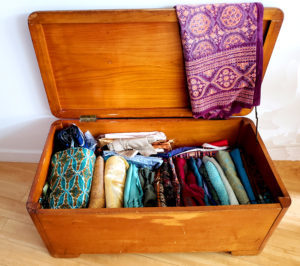
This blog is dedicated to Hattie Kate Agenbroad Howell of Toledo, Ohio.
The post Collecting Fabric as a Travel Souvenir appeared first on Klang Slattery.
August 2, 2020
A Mother’s Memories of her Son’s Boot Camp Graduation
Some years ago, I took an emeritus class at U.C. Irvine in Travel Writing. There I learned that a travel essay needs to be more than a travelogue. In order to interest a reader, travel writing should also have attitude. The writer’s voice is essential as it is through their eyes we view the adventure. I thought my blog readers might enjoy seeing some of the essays I wrote for that class. This one, A Mother’s Memories of her Son’s Boot Camp Graduation, shows that not all travel articles have to take you to foreign places. Though written in 2002, I think it is still relevant for its glimpse of our military and the young men who join.
* * * * * * *
Fall of 2002. The crowd is building. We have come from Texas, North Dakota, Oregon, Idaho, Missouri, Wyoming and even California — in fact, every state west of the Mississippi. A thin man in cowboy boots stands near me, his brown and callused hand resting on his wife’s waist. She is short and round, her tight jeans pulled in with a silver studded belt. Between them is a stroller with a sleeping toddler and two, stair-stepped, sunburned boys. A large Hispanic family, what must be cousins, aunts, parents and siblings, cluster together speaking Spanish. A young girl, her hair in tight corn-rows, sports a t-shirt with a big red heart and the words, “I love my Marine.”
What am I doing here? A Californian, born and breed, surrounded by the cream of the American Heartland. A liberal democrat standing shoulder to shoulder with a man wearing a National Rifle Association cap. A second-generation college graduate thrust among families who, I imagine, think of the military as the road to a better life. Yet there is a common thread that ties us all together. We are waiting with anticipation for the first glimpse of the sons, brothers, and boyfriends we haven’t seen in thirteen weeks. It is Family Day at the Marine Corps Recruit Depot in San Diego.
I love my country for its beauty and its freedoms, but I also carry a vivid memory of the reprimand I got in my first year of teaching for wearing a black arm band to commemorate the fallen on both sides of the Viet Nam conflict. I am aware of a cold hard lump waiting to explode in the center of my chest — an uncomfortable lump of fear and disapproval that contrasts with a sense of eager anticipation to see my son and what he has become.
The amplified voice of a drill Sargent pulls the crowd into a patio ringed by Spanish arches. He spews information and instructions about the day and involves some brave mothers in a contest to see who can best replicate the Marine Corps rallying cry. A variety of “Ooh-Rahs,” some high pitched, some low, at least one faltering, echo around the patio. Finally, it is time. “Be sure to get behind the sign with the correct platoon number of your loved one,” he warns.
Four deep, we jostle for a good picture taking spot. The platoons arrive, their red and gold flags waving in the sea blown breeze. My daughter nudges me and whispers, “There he is. I recognize his elbows.” This is helpful as they all look alike to me, each one slim and fit in olive drab t-shirt and running shorts. Only complexion and height offer any clue. They dare not smile or shift their eyes to left or right; the DIs are watching and notice everything.
The young man we search for is a squad leader and thus in the front row. For just a moment, pride smothers the cold lump that clogs my throat. Slowly the recruits begin to move, jogging in place near the sign with their platoon number, while cameras click frantically. Then there is a loud “Ooh-Rah!” and they are off for a swift four-mile circuit of the base.
Following instructions from the amplified voice, we surge toward the theater where we are told the motivational run will end. A holiday atmosphere is being pushed. There is a purveyor of soft drinks, water and candy. A tall Marine in a DI hat (the one that looks like what Smokey the Bear wears) leads Molly, an English bulldog dressed in a camouflage vest, around on her leash. Small children are allowed to pat her head. Some of us wander over to inspect the seven-foot high, wooden spirit displays standing on the theater steps. There is one for each platoon — all painted with more enthusiasm than artistic talent. I plant my feet behind the barricade and hold the space near the correct number chalked on the pavement.
The sweating recruits return and a tall, white-haired commanding officer delivers a welcoming speech. He is lean and fit enough to have run with this new class who are about to graduate from basic training. San Diego adds six-hundred young men almost every week all year round to the ranks of the United States Marines. The Parris Island Marine Depot in South Carolina trains both women and men and weekly graduates a similar number.
Later during the Emblem Ceremony, I feel the cold grenade in my chest stirring again. It feels as if someone has pulled the pin. The recruits march onto the Parade Ground in precise formation. Hundreds of them stand in perfectly straight rows, dressed in pressed khaki and olive drab, their close-cropped heads topped with the small boat shaped hat called a barracks cover. In the aftermath of September 11, now almost a year past, each recruit is entitled to wear the red and yellow ribbon on his breast signifying active service in time of war. All lined up and pinned in red and yellow, not one of them is old enough to remember Viet Nam, or any other war. I fear that to these young men, war is a chapter in a history book. Or a computer game.
Drill sergeants, assisted by squad leaders, move down the straight rows and present each young man with the black metal Eagle, Globe and Anchor pin that propels him to the official rank of Marine. Each new Marine proudly fastens the emblem to his own hat and returns to his place at attention. When it is over, we pour out of the bleachers to hug our sons who stand stiff and proud, but finally smiling. The very air vibrates with military zeal and patriotism and I allow my sense of impending danger to sink beneath the waves of pride.
There will be exactly six and a half hours of base liberty for the Marines. It is the first real free time they have had since boot camp began three long months before. Our son leads us around the public areas of the base and explains that the barracks and training fields are off limits. We pass groups of new recruits still in their early weeks of training. Our son points out that their pant legs hang loose over their boots. It seems the blousing of camouflage pants into combat boots is a privilage that must be earned. Our son wants to talk of home and hear news of his friends. We want to ask about what he has experienced but we don’t know the right questions to get more than one-word answers.
In the end, we sit at a green plastic table in a patio surrounded by the PX and fast food stands. A Hallmark store does a rousing business selling everything from mugs to stuffed animals, t-shirts to duffle bags, all advertising the Marine Corps. When we order soft ice-cream cones, I smile to hear my handsome, uniformed son call the lady who takes the money “Ma’am.”
Too soon the time is over. As good-byes begin in the orange glow of the setting California sun, I look around. The smooth faces of the new Marines show the confidence and assurance that marks them as men. There are no boys here, though their average age is only nineteen. But the question lingers in the air — where will they be in six months?

This photo was taken of my son in Iraq, about a year after graduation.
Author’s note: Within six months of his graduation, m y son was in Afghanistan as part of a six-man reconnaissance team. After 3 deployments and 8 years in the USMC, he returned to civilian life, attended university, graduated at the top of his computer engineering class, and settled in the Pacific Northwest. We count ourselves very lucky.
The post A Mother’s Memories of her Son’s Boot Camp Graduation appeared first on Klang Slattery.
July 17, 2020
A Lifelong Traveler Looks Back at her Passports
“I am a lifelong traveler, have visited every continent except Antarctica, and have not been without a valid passport since I was sixteen.” This quote, lifted from my Instagram bio, represents what I believed to be true until I began to write this post. . . . which says something about personal memory and the veracity of memoir. But more on that another time.
I love my collection of passports – each represents a different stage in my life and a different group of travel memories.
I got my first passport two months before my seventeenth birthday. My parents decided in early spring that the coming summer would be the perfect time for a family trip to Europe. This necessitated a rush to secure passports for myself and my seven-year-old sister (my parents both had well worn passports already). First a photo.
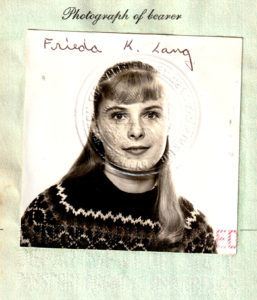 A typical teenager, I saw any photo shoot as an opportunity to make a personal statement. I imagine I perspired under the camera lights in the hand-knit, ski sweater I chose for the occasion. I loved that sweater because it had been made for me by my boyfriend’s mom. In spite of the fact that the sweater was far too warm for a southern California May afternoon, I wore it a statement of loyalty to my guy.
A typical teenager, I saw any photo shoot as an opportunity to make a personal statement. I imagine I perspired under the camera lights in the hand-knit, ski sweater I chose for the occasion. I loved that sweater because it had been made for me by my boyfriend’s mom. In spite of the fact that the sweater was far too warm for a southern California May afternoon, I wore it a statement of loyalty to my guy.
Issued on June 10, 1960, my first passport took me all over Europe, from Spain to Yugoslavia, from France to Germany. After that summer, I was hooked on travel.
I started my adult life with my second passport. I had just graduated from college and was on my way to graduate school in Mexico City. In those years (this was 1966) a passport was needed to travel in Mexico below a certain latitude. This passport has a stamp from the Mexican Consulate in San Diego and several entry and exit stamps. Though it isn’t as exciting as some of my others, this document reminds me of the joy of traveling and discovering without my parents. Besides, it’s fun to see the photo of twenty-three-year-old me. It seems so long ago that I was so young?
and was on my way to graduate school in Mexico City. In those years (this was 1966) a passport was needed to travel in Mexico below a certain latitude. This passport has a stamp from the Mexican Consulate in San Diego and several entry and exit stamps. Though it isn’t as exciting as some of my others, this document reminds me of the joy of traveling and discovering without my parents. Besides, it’s fun to see the photo of twenty-three-year-old me. It seems so long ago that I was so young?
 On August 20, 1971, six days after my wedding, I was issued a new passport (my third) in my married name. Two weeks later, Tom (my new husband) and I began our long international road trip. This is the trip of my memoir, Wherever the Road Leads. Passport number three holds so many visa stamps that two long, fold-out accordion pages were added to accommodate the red, green, blue and purple symbols of border crossings. This document carried me on a two-year honeymoon and a later romantic trip to Asia. In August of 1976, two months after my daughter was born, passport #3 expired.
On August 20, 1971, six days after my wedding, I was issued a new passport (my third) in my married name. Two weeks later, Tom (my new husband) and I began our long international road trip. This is the trip of my memoir, Wherever the Road Leads. Passport number three holds so many visa stamps that two long, fold-out accordion pages were added to accommodate the red, green, blue and purple symbols of border crossings. This document carried me on a two-year honeymoon and a later romantic trip to Asia. In August of 1976, two months after my daughter was born, passport #3 expired.
I was surprised to see that my fourth passport wasn’t issued until the winter of 1981. Four and a half years without a valid passport! So contrary to my own understanding of myself as a traveler. But, those were my “Mommy” years. For half a decade I was content with family camping trips around the west coast.
In 1981, with a chance to fly to Singapore to meet Tom and with my mother eager to care for Erin, I began my international traveling life again. Besides Singapore, my fourth passport has stamps for Hong Kong in both ‘81 and ‘82 and for a family trip to New Zealand in January of ‘85 with nine-year-old Erin and 18-month old Ethan in tow.
Much to my chagrin, I have discovered another lapse in my continuous line of passports – another three “Mommy years,” this time during Ethan’s childhood.
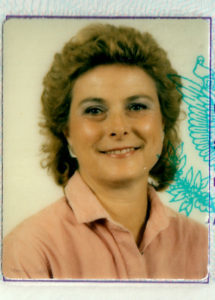 Passport #5 was issued in 1989. It took me to Denmark for my nephew’s wedding and to England to visit my aunt Edith. This is also the passport that was in my money-belt during the six weeks one summer when I led a group of teenage Girl Scouts on a five country European adventure we called “Europatrol ’98.”
Passport #5 was issued in 1989. It took me to Denmark for my nephew’s wedding and to England to visit my aunt Edith. This is also the passport that was in my money-belt during the six weeks one summer when I led a group of teenage Girl Scouts on a five country European adventure we called “Europatrol ’98.”
 Passport #6 was the magic carpet for more trips to England and a few wonderful “Elderhostel” tours —India with my sister, China and Australia with Tom. Passport number six also accompanied me to Chile and an assortment of countries in the newly established European Union. Passports of exploration, numbers six and seven represent my new, empty nest life. Travel was again a priority. Best of all, passport #7 carries a visa stamp from a 2017 Vietnamese adventure I shared with my adult daughter, now a world traveler herself.
Passport #6 was the magic carpet for more trips to England and a few wonderful “Elderhostel” tours —India with my sister, China and Australia with Tom. Passport number six also accompanied me to Chile and an assortment of countries in the newly established European Union. Passports of exploration, numbers six and seven represent my new, empty nest life. Travel was again a priority. Best of all, passport #7 carries a visa stamp from a 2017 Vietnamese adventure I shared with my adult daughter, now a world traveler herself.
This past summer, just before leaving for a road trip, I noticed that my current travel documents were set to expire on my July birthday. Desperate not to break the continuous string of passports I still believed in, I had my picture taken at the AAA office in Boulder, Colorado. That afternoon, I mailed in my documents, fee, and application. This compulsion to always possess a valid passport resulted in a striking record of this time in my life. Passport #8 is graced with the photo of an “older” woman with a startled expression and vivid turquoise hair, the result of a “fun colored-hair” phase I went through last year.
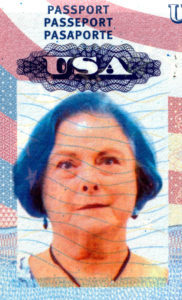 Due to health and safety restrictions on travel during the current pandemic, I have not yet used the turquoise-hair passport. It will be interesting to see what happens the first time I present this colorful document at TSA.
Due to health and safety restrictions on travel during the current pandemic, I have not yet used the turquoise-hair passport. It will be interesting to see what happens the first time I present this colorful document at TSA.
If you have a collection of passports like mine, how significant are they for you? Is there one that means the most and why?
The post A Lifelong Traveler Looks Back at her Passports appeared first on Klang Slattery.
July 4, 2020
Book Release in the Time of Covid
The summer of 2020 will stand out in history as the summer of Covid-19 – a time to avoid crowds at the beach and the amusement park, a summer when airports are more dangerous than sky-diving, and days of longing to gather with friends and family. The summer solstice has come and gone. But for most of us, at least in the US, July 4th Independence Day marks the beginning of full-on, serious vacation season. 2020 will be the summer of staycations. Those of us who have a pleasant patio, a comfortable lounge chair, and a good book will be the winners during this stay-at-home summer.
The Covid-19 pandemic has changed the way we approach everything from grocery shopping to a trip to the dentist, from lunching with friends to that planned trip to visit aging parents. I had hoped to release Wherever the Road Leads in the fall, launched with the fanfare of library talks and book-store readings. Now none of this can happen. I need to think outside of the box.
Online selling and buying is booming while consumers are stuck at home. E-book sales are set to overtake the sale of physical books, because many buyers are hesitant to order a physical book touched by strangers.
A traditional book release usually starts with the hardback. This, it is hoped, will lure impatient fans to buy the more costly version. The paperback edition follows about 6 months to a year later. Sometimes the e-book comes out concurrently with the hard-cover, sometimes a the same time as the paperback.
Would this standard schedule be the best way during these unstable times? Perhaps there is a plan that might work better in 2020.
With these thoughts rumbling about in my head, I decided to release my memoir of love, travel and a van on a somewhat odd timetable. The e-book will be available first, a tactic I hope will take advantage of escalating internet buying. I have set the release date for July 26. Later, with an eye to attracting holiday gift purchases, the hardcover edition will be released on November 30. After the high news days of the national election (and hopefully a slowing of the Corona virus), the paperback edition will be available in the end of January 2021 . . . . with additional fanfare and (hopefully) an actual launch party!
For e-book readers, the wait is almost over. In fact, the e-book version of Wherever the Road Leads is currently available for pre-order on Amazon and Smashwords, a distributor that supplies e-books directly, as well as to Apple Books and Barns and Noble.
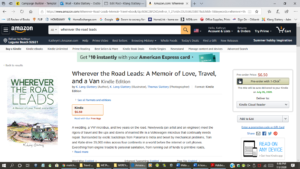
You can pre-order Wherever the Road Leads by following links below. Your e-book will be sent to your device on July 26:
https://www.amazon.com/Wherever-Road-Leads-Memoir-Travel-ebook/dp/B08C2BFZXD/ref=sr_1_1?crid=1C06OCV5KB3HE&dchild=1&keywords=wherever+the+road+leads&qid=1593820871&s=digital-text&sprefix=Wherever+the+Roa%2Caps%2C209&sr=1-1
https://www.smashwords.com/books/view/1029241
https://www.barnesandnoble.com/w/wherever-the-road-leads-k-lang-slattery/1137276841?ean=2940163014385
Questions about my memoir? An opinion about my odd release plan? Comments about my author page on Amazon? Please send your thoughts in the comment form below. Thanks. Katie
The post Book Release in the Time of Covid appeared first on Klang Slattery.



